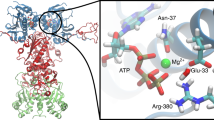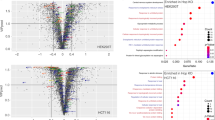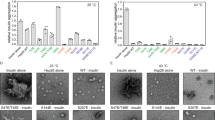Abstract
THE heat-shock protein Hsp90 is the most abundant constitutively expressed stress protein in the cytosol of eukaryotic cells1,2, where it participates in the maturation of other proteins, modulation of protein activity in the case of hormone-free steroid receptors, and intracellular transport of some newly synthesized kinases3–5. A feature of all these processes could be their dependence on the formation of protein structure. If Hsp90 is a molecular chaperone involved in maintaining a certain subset of cellular proteins in an inactive form, it should also be able to recognize and bind non-native proteins, thereby influencing their folding to the native state. Here we investigate whether Hsp90 can influence protein folding in vitro and show that Hsp90 suppresses the formation of protein aggregates by binding to the target proteins at a stoichiometry of one Hsp90 dimer to one or two substrate molecule(s). Furthermore, the yield of correctly folded and functional protein is increased significantly. The action of Hsp90 does not depend on the presence of nucleoside triphosphates, so it may be that Hsp90 uses a novel molecular mechanism to assist protein folding in vivo.
This is a preview of subscription content, access via your institution
Access options
Subscribe to this journal
Receive 51 print issues and online access
$199.00 per year
only $3.90 per issue
Buy this article
- Purchase on Springer Link
- Instant access to full article PDF
Prices may be subject to local taxes which are calculated during checkout
Similar content being viewed by others
References
Welch, W. J. in Stress Proteins in Biology and Medicine (eds Morimoto, R. J., Tissieres, A. & Georgopoulos, C.) 223–278 (Cold Spring Harbour, New York, 1990).
Lindquist, S. C. & Craig, E. A. A. Rev. Genet 22, 631–677 (1988).
Gething, M. J. & Sambrook, J. Nature 355, 33–44 (1992).
Pelham, H. R. B. Cell 46, 959–961 (1986).
Ellis, R. J. & Hemmingson, S. M. Trends biochem. Sci. 14, 339–342 (1989).
Buchner, J. et al. Biochemistry 30, 1586–1591 (1991).
Goto, Y. & Hamaguchi, K. J. molec. Biol. 156, 891–910 (1982).
Tsunenaga, M., Goto, Y., Kawata, Y. & Hamaguchi, K. Biochemistry 26, 4367–4373 (1987).
Kawata, Y. & Hamaguchi, K. Biochemistry 30, 4367–4373 (1991).
Welch, W. J. & Feramisco, J. R. J. biol. Chem. 257, 14949–14959 (1982).
Bradford, M. Analyt. Biochem. 72, 248–254 (1976).
West, S. M. & Price, N. C. Biochem. J. 251, 135–139 (1988).
Srere, P. A., Brazil, H. & Gonen, L. Acta chem. scand. 17, S129–S134 (1963).
Buckel, P. et al. Gene 51, 13–19 (1987).
Johnstone, A. & Thorpe, R. Immunochemistry in Practice 55–59 (Blackwell Scientific, Oxford, 1987).
Wetlaufer, D. B. Adv. Prot. Chem. 17, 303–389 (1962).
Buchner, J. & Rudolph, R. Bio/Technology 9, 157–162 (1991).
Schmidt, M. & Buchner, J. J. biol. Chem. (in the press).
Author information
Authors and Affiliations
Rights and permissions
About this article
Cite this article
Wiech, H., Buchner, J., Zimmermann, R. et al. Hsp90 chaperones protein folding in vitro. Nature 358, 169–170 (1992). https://doi.org/10.1038/358169a0
Received:
Accepted:
Issue Date:
DOI: https://doi.org/10.1038/358169a0
This article is cited by
-
Potentials of single nucleotide polymorphisms and genetic diversity studies at HSP90AB1 gene in Nigerian White Fulani, Muturu, and N’Dama cattle breeds
Tropical Animal Health and Production (2024)
-
The Hsp70–Hsp90 go-between Hop/Stip1/Sti1 is a proteostatic switch and may be a drug target in cancer and neurodegeneration
Cellular and Molecular Life Sciences (2021)
-
Targeting the Hsp90-Cdc37-client protein interaction to disrupt Hsp90 chaperone machinery
Journal of Hematology & Oncology (2018)
-
Functional disruption of peroxiredoxin by bismuth antiulcer drugs attenuates Helicobacter pylori survival
JBIC Journal of Biological Inorganic Chemistry (2017)
-
Crosstalk between cellular compartments protects against proteotoxicity and extends lifespan
Scientific Reports (2016)
Comments
By submitting a comment you agree to abide by our Terms and Community Guidelines. If you find something abusive or that does not comply with our terms or guidelines please flag it as inappropriate.



